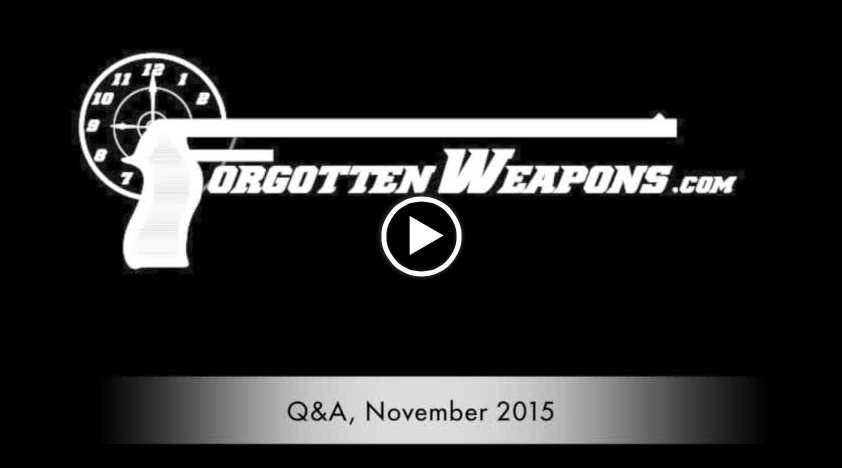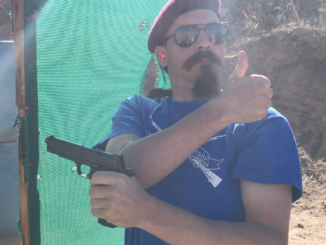This is an interesting single-shot breechloading system built by Kuhn of Besançon – a city near Switzerland in eastern France. It is clearly a sporting rifle, firing an 11mm black powder cartridge and probably dates to the 1870s or 1880s. It automatically ejects an empty case when opened and automatically cocks the hammer when the action is closed, making it a cleverly efficient system to shoot. The trigger is also not actually operable until he lever is fully closed, rendering it safe from out of battery firing. I don’t know anything about the maker, however…
Related Articles

Artillery
Book Review: A Gun For All Nations
I ran across a mention of this book while trying to find some information on this 37mm Hotchkiss machine gun – and this book was the only reference I could find any mention of it […]

Needlefire
Q&A Video, November 2015
November 6, 2015
Ian McCollum
Needlefire, Paper cartridge, Percussion, Revolver, Semiauto pistol, Video
17
Thanks to the awesome people supporting Forgotten Weapons through Patreon for sending in more questions that I could get to for another month! This month the subjects include: Browning lock vs others in handguns Best […]

Competition
Shooting the MAC 1950 in Tactical Competition
Following up on yesterday’s discussion of the history and mechanics of the Pistolet Automatique Modele 1950, today I am running it in a run-n-gun pistol match. The gun worked well for me, not having any […]

In so far as this looks like an improved Winchester 1885 (Browning’s patent drawing here: https://www.historicalfirearms.info/post/130225555674/brownings-first-rifle-winchester-1885), I should date this rifle no earlier than that. The figure-eight shaped link between hammer and action mimics the link between lever and breechblock in the Browning design. Browning himself improved on the Sharp’s action (the 1885 was self-cocking). Monsieur or Herr Kuhn seems to have improved on that in turn, this action not only being even further simplified (a feat in itself), but also self-ejecting, easier to strip and clean, and possessed of the lever lock and that very effective out-of-battery safety. I’ll bet the trigger pull is very nice too. I suspect this gun is obscure because the maker was infringing a patent — unless it was made before 1883. However, a very nice gun and very good to be made aware of it here. Thanks again to Mr. M.
J.H.Kuhn was a specialized maker of sporting guns and target pistols. See one of his pistols here: https://www.cowanauctions.com/lot/french-rolling-block-target-pistol-by-kuhn-4004168.
I watched the video twice trying to figure out what those large ovals at the top of the receiver were for. I have owned and shot many single shots but I can’t see any value. I can’t believe he went to that much work for ascetics. The rifle appears to be well thought out and all business. I was a bit surprised that there were no distance markings on the rear sight. It looks like it would be a perfect weight and balance for off hand shooting.
Those ovals look to be an area of beefed-up metal in the join between the rear bearing surface of the breechblock and the breechface. Presume they are there to increase the strength and stiffness of the action in this critical area.
Well, we don’t want the receiver to explode in someone’s face.
In English, The shaped ovals of extra metal would be known as “Bolsters”
Bolsters appear around the corner of the action on some shotguns and break open rifles, even by some very high end makers like Holland & Holland and Purdey.
They’re actually something of a fashion feature, as it is entirely possible to design sufficient strength into a break open action for it to handle .460 wetherby mag, without excessive weight and without bolsters.
In the Gun Collector’s Digest Vol. 1, 1974;
https://www.amazon.com/Gun-collectors-digest/dp/0695804324
There is an article on the 10.4mm Dutch East Indies revolver. The author was trying to find a Chamelot-Delvigne system revolver to add to his reference collection, and instead found the East Indies type, which is distinctly different. The DEI revolver merits a one-sentence mention in Boothroyd’s The Handgun.
What that has to do with this is that in the process the author found another similar revolver, definitely neither the DEI or a standard Dutch 9.4mm service revolver, that seemed to have mechanical aspects of both.
Inlaid in gold on the lower left side of its frame was the legend;
SYSTEM KUHN
In all capitals, and italicized.
He was unable to learn any more about that revolver.
Somehow I think it unlikely that there were two different arms designers working in Europe around the 1880s with that name. So I would suggest that this rifle, and that revolver, were probably the work of the same person.
cheers
eon
I KNEW I had seen “System Kuhn” before!
Kuhn sounds like “coon” in English, spoken VERY fast.
At http://fr.1001mags.com/parution/gazette-des-armes/numero-187-mars-1989/page-44-45-texte-integral-0 you may find an article “Une Carabine Kuhn”, a gun chambered for 10.4x38R Swiss rimfire cartridge (used also in the Vetterli rifle) built in the late 1860s.
The article says that in 1870 a version for the centrefire cartridge was built; perhaps the version is shown in this video.